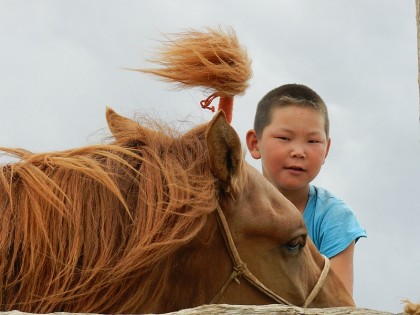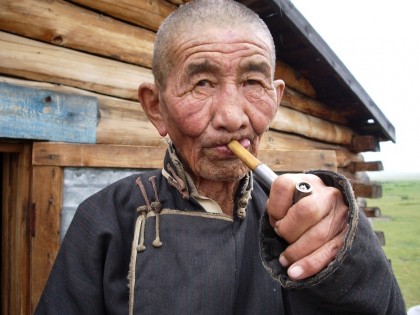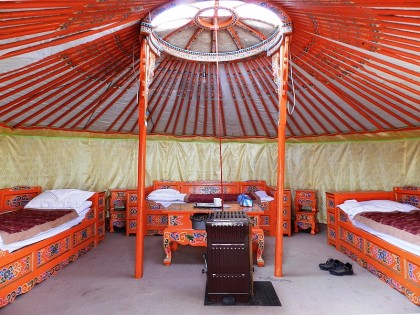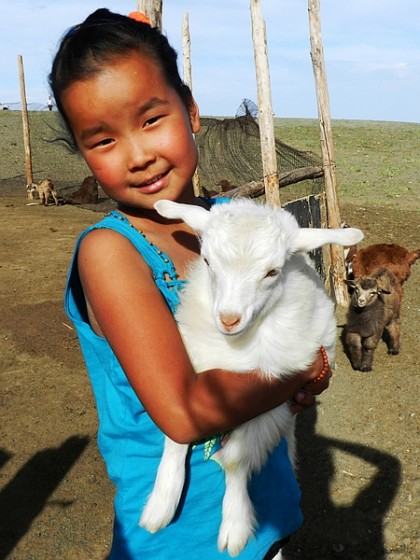
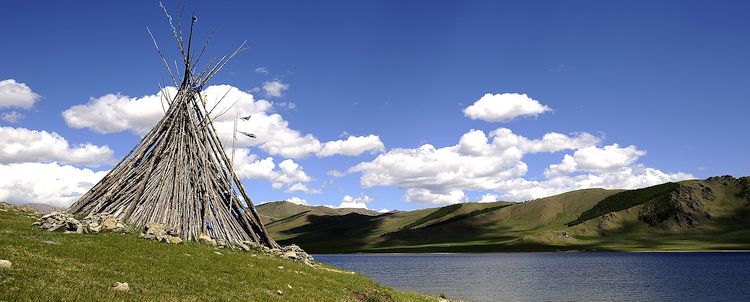
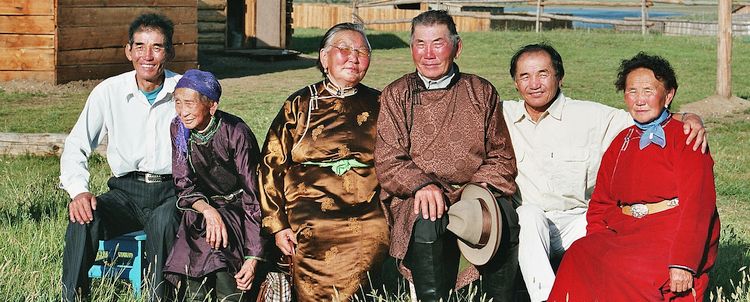
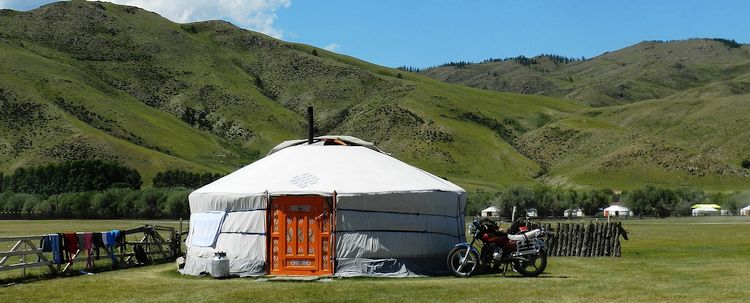


Wide Steppes, Galloping Horses and Resonant Songs
Best Travel Period | Mongolia in Brief | Peoples and Religions | Food | Flora and Fauna | National Parks and Nature Reserves | History | Economy | Festival Calendar | Mountain Scenery and Trekking
In Mongolia, which is with an area of over 1.5 million square kilometers the second largest landlocked country of our earth, live today only about 2.9 million inhabitants, one third of them in the capital Ulaanbaatar. Surrounded by the People's Republic of China and Russia, consists Mongolia largely of high mountain ranges and arid high plateaus, however because even though many glaciers are within the territory, and 1,200 rivers cut through the land, they transport the water above all away, into the surrounding areas.
Visit with us a people who once created the largest contiguous empire in the world under Genghis Khan, and whose members today mainly live in the traditional nomadic culture and practice the Buddhism and shamanism of their ancestors. Over seemingly endless steppes, under an infinite blue sky, they move with their families and their cattle, always in search of fresh pastures. Here in Mongolia stunning natural beauty and a traditional way of life is combined, it holds a lot for us, exotic and fascinating, for culture enthusiasts as well as for nature lovers.
For horse enthusiasts, Mongolia offers the unique opportunity of meeting with the Przewalski's wild horse in its original habitat, even if the numbers have greatly diminished, due to the extremely shy nature of the animals, and they are found almost exclusively on the territory of the Hustain National Parks. Whether you thereby would like to spend your holidays in Mongolia on horseback, and participate travelling with a group of nomads on a horse-trekking, or whether you roam the country in comfortable vehicles, in the hotel or stay authentically in well-equipped yurts, remains of course left to your personal preference.
We would like to help you with individual advice, so that your bridge to Central Asia, your bridge to Mongolia, is designed precisely in such a way that this trip offers the best experience for you. You will be impressed by the singing dunes in the Gobi desert, bathe in natural hot springs, admire cave paintings from the Bronze Age, and feel the ancient power of wildness in the people and the landscape up close - experience Mongolia!
Best Travel Period
To Mongolia you travel most comfortably in the period from May to October, and depending on the region, the recommendations are slightly different. If you want to move around a lot within the Gobi desert, should avoid the hottest summer months of June, July and August, here the temperatures rise partly to +40 ° C. The winter, which can bring snowfall from November to April, is extremely cold and uncomfortable through the strong winds, and is definitely not recommended as a travel time.
Mongolia in Brief
| Location | Mongolia is is located in the heart of Central Asia. To the north it borders on Russia, to the east, south and westto the People's Republic of China. |
| Area | 1.564.116 km² |
| Population | 2.953.190/ 1,9 per km² (2014) |
| Capital | Ulaanbaatar |
| Districts | 21 Aimags (provinces), which in turn are being divided into 331 Sum (counties). Ulaabaatar forms an additional administrative unit next to: Bajan-Ölgii, Uws, Chowd, Zawachan, Gobi-Altai, Chöwsgöl, Archangai, Bajanchongor, Bulgan, Orchon, Öwörchangai, Ömnö-Gobi, Dund-Gobi, Töw, Selenge, Darchan-Uul, Chentii, Gobi-Sümber, Dorno-Gobi, Dornod and Süchbataar. |
| Topography | Mongolia is an expansive highland with an average altitude of ca.1580 m above sea level. 80% of the territory are more than 1000 m above sea level. In the west, north and south are high mountain ranges (Altai), the highest peak, the Chüiten, reaches a height of 4374 m. In the center of the country are the Changai- and the Chentil Mountains, the south and east are dominated by dry plateaus (Gobi). |
| Vegetation | The flora of Mongolia is multifaceted, ca.2500 plant species are known. To the north are also some extensive pine forests, however with increasing aridity, the vegetation towards the south, is getting shorter and merges into extensive grasslands. In the high mountains typical alpine vegetation is found, including edelweiss, gentians and turk's cap lily. |
| Wildlife | The fauna features some superlatives, including populations of worldwide very rare wildlife species such as snow leopards, wild camels and the desert bears "Mazaalai" in the Gobi desert, also to highlight is the Przewalski's wild horse. Otherwise the common mammal species are adapted to their environment and rather small: Wolf, wild goats and gazelles, marmots and gerbils. Also a relatively high number of different species of birds live here: cranes, buzzards, steppe eagle and various fowls. |
| Climate | Mongolia is a landlocked country with southward increasingly dry continental climate. In addition, Mongolia is among the sunniest countries in the northern hemisphere, with about 260 sunny days a year. And the summers are warm, the winters very cold. |
| Temperatures | The summer temperatures range between 10 ° C and 15 ° C at night, in the daytime up to 32 C ° are reached. In winter it becomes very cold, daytime highs are between -15 ° C and -25 ° C, at night the temperature can drop down to -35 ° C. |
| Precipitation | Each year only about 233 mm. In August one has to expect some more continuous rain in the region around Hovsgol, in the north east of the country. |
| Languages | The official language is Mongolian. Approximately 85% of the Mongolians speak Khalkha Mongolian as a mother tongue, around 8% speak a Western Mongolian, 5% a Kazakh (Turkish) dialect. Furthermore, Russian, Chinese, Evenki, Tuvan, Uighur. English is being taught in schools since 2005 as the first foreign language. |
| Ethnicties | Khalkha Mongols (about 85%), Kazakhs (approximately 5%), further Dörwöd, Bajad, Buryat, Dariganga, Zach Chin and Uriankhai. |
| Religions | The kind of Buddhism, to which almost all Mongols belong here, is strongly permeated by shamanistic elements. The minority of 5% Kazakhs belongs predominantly to Islam. |
| Economy | A lot of the people in Mongolia are engaged in animal husbandry, 5 (sacred) animal species are traditionally especially bred here: sheep, goats, cows, horses and camels. Agriculture is greatly limited due to the poor soil, a little wheat, millet and rye grows. Mining has become increasingly important, the extraction of copper, gold, bituminous coal and other minerals. Main export goods are already today the mined ores and minerals, as well as raw materials of animal origin. |
| Getting there | Flight to Ulaanbaatar via Berlin, Frankfurt, Moscow, Beijing, Seoul, Tokyo / Osaka. Travel by train via Moscow with the Trans-Siberian Railway. |
| Visa / Entry permit | For the entry into Mongolia a passport and visa are required. |
| Vaccinations | In addition to the usual vaccination, immunizations against hepatitis, encephalitis, typhoid and rabies are recommended. |
Peoples and Religions
In Mongolia live an average of less than two people per square kilometer, fewer than anywhere else in the world. The country is home to several ethnic groups with their own cultural characteristics, the majority of the population, however, consists of Mongols who have been settling here since prehistoric times. However, their languages in local dialects differ so much, that they have to be considered as separate languages. This concerns the language of the Buryat in the north, that of the Mongols in Dornod, Chentij, Selenge and Dagur. Also Darigana is a special dialect, but which can still be seen as "Mongolian". The Mongolian peoples in the West differ even more significantly from the original language: Here one can find the Oirats and the Darchad, which also are strongly different culturally.
They talk western Mongolian languages, while the Khalkha are summed up as East Mongolian along with some Mongolian languages which are spoken in China. Apart from the Mongolian peoples, there is a small minority of Evenk in the north and west. Additionally to this, there is a number of immigrated, turk speaking tribal communities, such as the Tuvan and the Uighur. Akin to the Tuvan are the Uriankhai and the Zaatan, who however by now have adopted Mongolian dialects. A special role have the Turkic speaking Kazakhs. They live isolated from the Mongolian society, and don‘t speak any Mongolian, they are oriented towards Kazakhstan, from where they had emigrated about a hundred years ago into their settlement area of today, in the far west of Mongolia. In the 1990s, after the dissolution of the Soviet Union, many of these people have returned to Kazakhstan, some only for a short time though.
Like the Uyghur they belong to the minority of Muslims, whereas most other nations are lamaistic Buddhists or shamanists. There is also a small Chinese and Russian minority. The Mongols were predominantly shamanists to the 15-16th century, and practiced the rituals of Tengrism, then the lamaistic Buddhism had been enforced by external influences, and there was a relatively large amount of monks who studied Tibetan and Sanskrit, respectively Pali. With the exception of the communist period, in which any form of religious practice was officially banned, Buddhism is to this day the predominant religion, even if it is so strongly permeated by shamanistic tendencies, that scientists are barely able to determine the predominant religion.
Food
For the Mongols, the most important and richest meal is breakfast, followed by lunch, in which is also still being served plenty. The main part of a meal always consists of meat, common vegetables are onions, garlic, beet and cabbage. Served as side dishes is often rice, as well as dairy products. One of the most frequently prepared recipes are the "Buuz". For these filled pastry pockets are required - of course – meat, which is seasoned with salt and pepper, onion and garlic, then placed in a small pastry, made only of flour and water, and cooked in steam. Also Khuushuur and Bansh are made from the same ingredients, although they vary in size, and are fried respectively boiled. As one in Mongolia particularly likes to use fat mutton meat, the Buuz get an intense flavor. People drink tea with milk, fermented mare's milk and an alcoholic beverage made from fermented mare's milk. For the European palate, the diet of the Mongols needs some getting used to, because of the high fat content of the meat, also vegetables and fruits one is likely to miss fast. Fortunately, everything is sufficiently available in the larger towns, and many hotels have also adapted to Western cuisine.
Flora and Fauna
The flora and fauna of Mongolia is amazingly varied in spite of the barren climatic conditions. In the north of the country falls the most precipitation, and there thrive vast coniferous forests of Siberian larch Larix sibirica, pine, spruce and Siberian fir Abies sibirica, which are dotted with individual birch trees and are populated by wolves, various species of deer, lynx, fox and beaver, marten and rabbits as well as some squirrels. Also the typical alpine vegetation is found here with gentian, edelweiss and other low, flowering herbs. In the adjacent grasslands, whose vastness is interspersed only now and then by a small wood, or a group of low bushes, roam herds of bison, European bison, yaks, sheep and goats - partly as wildlife, partly as a domesticated herd.
The further you advance to the south, the lower the vegetation becomes, and a seemingly endless steppe is opening up, because for larger plants falls no longer enough precipitation here. Finally, the vegetation goes back even further, the dryness of the (semi-) desert Gobi lets only a few grasses and very sparse bushes grow. Up to this point venture only few herds of animals, here the domestic groups are above all to be found, which were conducted here on purpose.
Unfortunately the intensive livestock farming, especially of cashmere goats, endangers the survival of the grasslands significantly. Nevertheless live in the Gobi desert some of the rarest animals on earth, such as the snow leopard, the Gobi bear "Mazaalai" Ursus arctos isabellinus, a smaller relative of the brown bear, and many different birds such as the swan goose, Eurasian teal, snow bunting, mute swan and snow owls, which partly find their winter quarters here. Furthermore live in the waters of Mongolia many different species of fish, here is as the rarest specimen probably the Baikal sturgeon to be mentioned.
National Parks and Nature Reserves
Mongolia has established a number of national parks and nature reserves. Particularly interesting are the Gobi desert, the eastern Mongolian steppe and the northwestern Mongolian high mountain range.
Gobi Gurvansaikhan National Park
This park in southern Mongolia was founded in 1993. It lies in the north of the Gobi desert and is with its 27 000 km² the largest national park of Mongolia. The eastern half of the park is located in the Gurvansaikhan mountains, in higher regions dominates the steppe with rare plants and animals such as the snow lion and the Gobi camel. The sand dunes Khongoryn Els (singing sand) are also popular attractions like the Yolyn Am valley, which has a large ice field, which you can admire most of the year.
Gorkhi-Terelj National Park
This famous National Park with more than 250 species of birds lies not far from the capital. Attractions include the 20 m deep glacial lake KhagiinKhar, the Yestii thermal springs and a Buddhist monastery.
Lake Khövsgöl National Park
Situated between the Central Asian steppe and the Siberian taiga is Khövsgöl, one of world's only 17 lakes that are more than 2 million years old. It is the largest drinking water reservoir in the country. The park also provides habitat for many wild animals from ibex, argali, moose, wolf and muskox till the brown bear.
Khan Khentii Strictly Protected Area
The park, which is barely visited by tourists, in the province of Khentii, bordering on the Siberian taiga is ideal for horse trekking in the beauty of truly untouched nature.
History
In the past, some 500,000 years ago, there was a very pleasant climate in what is now Mongolia, which brought forth fertile soil, extensive woodland and a bustling variety of animals (mammals). Already from dated this period one finds some most simple tools, which are associated with the very first ancestors of Homo sapiens. Since that time, the stretch of land has been continuously inhabited, even though with the glacial period and tectonic changes a much harsher climate found its way into the country. Warring nations settled here, and provoked the Chinese emperor Qin Shihuangdi in the 7th century BC. to the construction of the Great Wall of China.
Mainly one name made Mongolia world famous at that time: Genghis Khan (originally: Temüüdschin - the blacksmith ) . The famous leader united around 1200 of the Mongol tribes, and led them to victory against several neighboring nations. After his appointment as the Great Khan of all the Mongols, Genghis Kahn began with the conquest of other areas, in the east he penetrated as far as the Sea of Japan, and in the west he reached near the Caspian Sea. To maintain the resulting immense empire, he got his own writing developped, and set binding, written laws. His reign was the beginning of the Mongol era, which lasted until the 17th century. But then the kingdom perished under the Manchurian rule, which at that time enthroned the Emperor of China; for several centuries there was a clear Chinese influence.
There were many Chinese immigrants, and some Mongolians learned the Chinese language. Mongolia became now more or less forgotten for about 200 years. Only at the beginning of the 20th century, the Mongols gained their independence from the Manchu dynasty. After that, Mongolia was a satellite state of the Sowjet Union from 1921 onwards. In 1990 came democratic change, and Mongolia is a democratic republic with a Western a type of market economy ever since.
Economy
Mongolia had economically great difficulties in adapting to the challenges of the free market economy. Approximately one third of the population works in agriculture until today, however the barren soil actually only allows cattle breeding, and very little crop planting can be done. With the cattle farming (sheep, goats, yak, horses and camels) about 20% of the gross domestic product is created today, the crops play a subordinate role.
However, from an environmental point the economic struggle is harmful to the nature of the country: the high air pollution from coal-fired plants is only somewhat opposed by the vastness of the sky, many stands of trees had been cut down for the population‘s own needs, and overgrazing of the grasslands has serious consequences for the ecosystem. Only in the last decade, awareness has risen to these problems in Mongolia, and appropriate countermeasures have been taken, which could luckily retain a large portion of the natural habitats. A stabilization of the economic conditions in Mongolia could finally be achieved through an extension of the mining activities. Mongolia boasts of large deposits of the increasingly important metals gold, copper, zinc, nickel and molybdenum, while generating good export earnings with stable prices.
Festival Calendar
The certainly most important festival of Mongolia are the national holidays Naadam, held annually from 11th to 13th of July. During these days competitions take place throughout the country, in which the men measure themselves against each other in combat and archery, and let their horses compete in different races. A counterweight for this are the International Women's Day on March 8th, and Mother and Child day on June 1st. November 26th is the Mongolian Independence Day, this day is then celebrated altogether a bit quieter. Other important festivals are determined by the lunar calendar, above all, the Tsagaan Sar - the Lunar New Year, which takes place in January or February. On request we‘ll integrate certain holidays of Mongolia into your travel time window - you just call us and we plan according to your interests!



